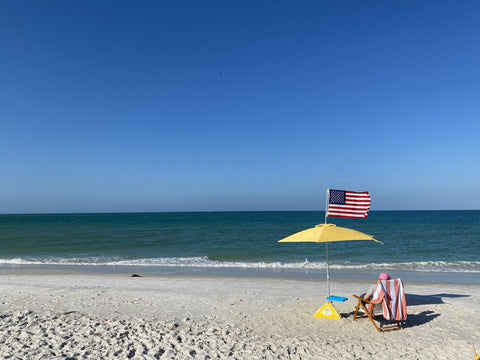As you plan your next beach day, there's an important new consideration beyond sunscreen and swimsuits: the safety of your beach umbrella.
ASTM International's consumer products committee has recently introduced a new safety standard, F3681, that aims to significantly reduce the hazards associated with beach umbrellas. This new standard focuses on the secure anchoring of umbrellas to prevent them from becoming airborne—a risk that can turn a relaxing day at the beach into a dangerous one.
Below, we’ll delve into what this new standard means for you, the beachgoer, ensuring your next shore excursion is as safe as it is enjoyable.
The ASTM F3681 Standard Explained
ASTM International, a globally recognized leader in the development of safety standards, has taken a major step forward with the creation of the ASTM F3681 standard.
This initiative addresses critical safety risks identified in previous years. Beach umbrellas, often seen tumbling across the sand on windy days, can become lethal projectiles. The tragic reality, underscored by incidents like those suffered by consumers such as Ed Quigley—who was severely injured by a rogue umbrella—highlights the urgent need for standardized safety measures.
The new safety guidelines set forth by this standard ensure that all 7.5-foot diameter beach umbrellas must withstand winds up to 30 miles per hour and require anchoring systems capable of providing 75 pounds of resistance.
This standard, developed with contributions from Consumer Product Safety Commission (CPSC) engineers, not only promises to safeguard beachgoers but also pressures manufacturers to innovate safer, more reliable products. Through this standard, ASTM aims to transform beach safety protocols, turning casual beach visits into much safer outings.
What the Standard Means for Beachgoers

The implementation of the new ASTM F3681 standard is a game-changer for individual beachgoers. Its primary goal is to mitigate the safety risk of beach umbrellas turning into dangerous projectiles during windy conditions. This new standard not only enhances overall safety but also boosts consumer confidence in beach umbrella products.
For beach lovers, this means that their leisure time by the sea will be safer as they’ll be less likely to encounter or be harmed by an airborne umbrella.
Manufacturers are now required to include proper anchoring devices with their umbrellas, or at least recommend effective anchoring solutions, which were often overlooked in the past.
As a result, users who unfold their beach umbrella and secure it into the sand, can rest easier knowing that it adheres to rigorous safety checks designed to withstand typical coastal winds.
How to Choose Safe Beach Umbrellas Under the New GuidelinesChoosing a beach umbrella that complies with the new ASTM safety standard involves more than just picking the right color or size.
Here are some practical tips to ensure you select an umbrella that is not only stylish but also safe:
- Check for Compliance Labels: Look for labels or tags that indicate the umbrella meets the ASTM F3681 standard. This label ensures that the umbrella has passed the necessary safety tests. Non-compliant umbrellas will soon carry a warning label stating that they do not meet the ASTM F3681 standard, helping you to make a safer and more informed purchase.
- Examine the Anchoring System: The standard requires umbrellas of 7 ½ feet to have an anchoring system capable of providing 75 pounds of resistance or remaining secure in winds up to 30 mph. Make sure the umbrella you choose comes with a robust anchoring system.
- Assess the Build Quality: Higher-quality materials and construction mean better durability and safety. Check the joints and the quality of the material used for both the canopy and the pole.
- Evaluate Size and Weight: Larger umbrellas must meet stricter safety standards. Ensure that the size of the umbrella corresponds with an appropriate and practical anchoring system that won’t be cumbersome to set up.
- Seek Recommendations: Don't hesitate to explore customer reviews online for firsthand insights. Feedback from those who have already used the umbrellas can provide valuable information about their performance in real beach conditions.
- Consider Portability and Ease of Use: While safety is paramount, the umbrella should also be easy to carry and install. A cumbersome umbrella that is difficult to set up correctly might tempt you to take shortcuts that could compromise safety.
Ensure Your Beach Day Is Safe and Fun With beachBUB

At beachBUB, we understand that choosing the right beach umbrella goes beyond color and style—it's about ensuring safety and durability. We are proud to offer the beachBUB® umbrella systems, which include the ASTM compliant ULTRA umbrella base.
Here’s what you can expect from beachBUB’s umbrella systems and ULTRA base:
- Compliance: Our umbrella systems include the beachBUB ULTRA umbrella base, which meets and exceeds the ASTM F3681-24 standard.
- Safety: Our beachBUB ULTRA umbrella base holds up to 125 pounds of sand, ensuring stability in winds up to 30 mph and is tested to withstand even stronger winds up to 44 mph. It also features a canopy that offers a UPF rating of 50+ for excellent UV protection.
- Quality: Our high-quality beach umbrella systems are constructed from premium materials to enhance longevity and come with a 3-year protection plan on the frame.
- Ease of Use: Our umbrella systems are lightweight and can be easily set up in just 2 minutes.
- Great Reviews: Our products are consistently praised for their reliability and ease of use, earning over 5,000 5-star reviews.
Not looking to invest in an entirely new umbrella system? No problem. Our ATSM-compliant ULTRA umbrella bases are compatible with any 7.5-foot diameter umbrella.
Upgrade your beach experience with beachBUB today—visit our website to see how we can make your beach day safer and more enjoyable. Because a safe beach day is the perfect beach day.
